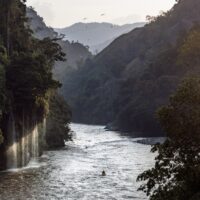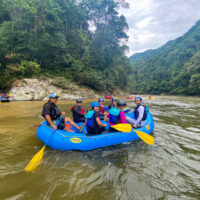Colombia is a country of an exuberant bio-diversity, second in the world, if you believe the number. Colombia’s incredibly diverse bird population is officially the greatest in the world. There are Jaguars and spectacle bears, whales and fresh water dolphins as well.
If you look at a map, you will see high mountains, glaciers, jungles and deserts…

In a few words, when it comes to the wilderness, there are not many things you won’t find in Colombia. However, when it comes to finding where and how to experience Colombia’s natural places first hand, things start to get a little tricky.
There are few selected companies that will offer authentic experiences, with world re-known experts and guides, but for people who aren’t too interested in hiring a professional, or jumping on an organized adventure, exploring Colombia’s wild area on your own is very different than what you might be used to back home.
For example, trekking. There are trails everywhere and in every mountain passage, but there are no maps, or signs, and often little to no information about the routes that are achievable. These trails are almost exclusively used by local farmers, called ‘Campesinos’, to access their remote farms and homes. In many cases, areas of the mountains are also under indigenous authorities, and they each have their own protocol for granting access to their territories for foreigners.

Those rural communities, whether they are indigenous or not, function on very tight social bases, where everybody watches out for who does what, and who comes and goes from the valley. As a foreigner, walking into one of these areas, where the hiking appears to be good, however people are not used to seeing solo hikers and you will immediately be signaled and stopped for questioning. The 3 basic questions are: Who are you? Why are you here? And where are you going?
Now, do not get miss-lead by the questioning, rural communities are the most welcoming and kind-hearted people in Colombia, but their past history has made them protective and cautious; They want to know what is going on in their territories.
Sure enough, after getting the right foot in the door, they will probably invite you into their home, or provide someone to show you the best waterfalls or viewpoints around their village, and it will be a great experience. Never-the-less, it’s not ideal to come unannounced in an area you don’t know and simply wonder around the mountains. You may cause grief, stress, or become suspicious to them. Also, there is no ‘search and rescue’ in Colombia, and weather patterns are very capricious and can lead to sudden changes within a few minutes. These environments should be approached with local knowledge.

Here are our 3 recommendations to exploring Colombia’s most remote places on your own:
- Go with a local or someone who knows the area and can introduce you to the communities
- Do extensive studies of the area you are going to and gather as much first-hand information you can before venturing into the unknown. Do not hesitate to change plans if you see the area isn’t safe. Do not trust maps, as certain roads and trails may not exist. The layout of the land if often very different than what is portrayed on the maps.
- Be prepared to deal with any situation on your own. No helicopters will come for you. You need to be taking half the risks you would normally take when back home.
Even with these few tips, remember that Colombia isn’t a country that has been exposed to adventure sports for very long. If you are going into a national park or a well-known area, people are used to seeing trekkers and such. But if you plan to go into a place that does not see much traffic, you could easily be the only foreigners the locals see that year.
For them, the memories of the armed conflict are still fresh in history, and seeing ‘Gringos’ in their gore-tex jackets, hiking boats and fancy backpacks, often represent a culture shock.
Their conception of territory is very different, and in some cases, they are not pleased to see people walking in their valley and setting up their bright coloured tents in their fields. It is important to approach everyone with the upmost respect, and ask for permission for any thing you do. Keep in mind that the government does not invest in fixing trails and secondary roads. The locals have to make great effort in order to maintain access, and they often do it by hand, in big community efforts called ‘Minga’.

As tourism develops, and more foreigners arrive, rural communities are starting to understand how things work. To some it is not normal that people who are not from the valley, and never help in maintaining the trails, come and walk around. They expect a contribution, or at least to be hired for the day, and make a dime to live another.
Colombia is one of those countries where adventuring on your own, is much less safe, and less interesting than to go with locals or professionals. This country is about sharing, as it is a place where everyone comes together. Although it is perfectly understandable that, as outdoor enthusiasts we want to get out there by our own means. However, to truly embrace Colombian Natural heritage, you also have to embrace its cultural heritage!
Trying to skip the organized adventures, tours or guided expedition, is a natural instinct of any adventurer, but here in Colombia, skipping the tourist attraction, doesn’t make you not one!
So get out there, find your paradise, explore, but make sure to do it respectfully of the locals. There is so much to learn from them, and they will make your adventure so much richer.

RELATED ARTICLES

Samaná Fest: An event to protect the Samaná River
Written by: Jules Domine Eastern Antioquia is iconic in Colombia for being the birthplace of narco trafficking, and former home […]
Read more
Samaná Fest: Celebramos el Río Samaná
Written by: @mariacamila.gh96 Expedition Colombia, de la mano con otras entidades, llevó a cabo un festival de 3 días, […]
Read moreOne comment
Leave a Reply Cancel reply
This site uses Akismet to reduce spam. Learn how your comment data is processed.

Hi, we are interested in doing a zip lining tour or maybe horseback riding do you have a company you can recommend? I would be really interested in booking a tour today. Thank you so much!